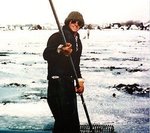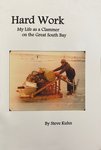

The alchemy of nature has a calling some answer if they’re lucky.
Steve Kuhn followed the vocation that was offered. The glint of the sun on the water, puffy clouds, warm summer air, the feeling of freedom—all those were magical lures. So was being your own boss.
Kuhn, who lives in Sayville, began his clamming career as a teen. “I was 19 in my second year at Suffolk County Community College and I remembered the first day I was out,” he recalled. “I was hooked. It was beautiful.”
It’s been an over 50-year journey; he still motors out on his 20-foot Garvey from Brown’s River a couple of times a week. But he wants his story about a clamming life out there. He has clammed in Bayport, Barrett Beach, Watch Hill, Patchogue, East Islip and Babylon waters. He even had a five-year stint in Staten Island and his book, “Hard Work: My Life As a Clammer on the Great South Bay,” chronicles a lifestyle that’s disappearing.
“Every day is an adventure,” he said of the challenges. “And things can change in an instant. It can go from flat, calm water to 20-mile-per-hour winds. I’ve been out in rainstorms, snow where you couldn’t see in front of you, on ice. I’ve been out in 5-degree and 100-degree weather.”
He has survived thunderstorms with lightning bolts that crackle through the middle of the bay.
“Boom, boom, boom,” he said, recalling jagged flashes. “A lot of times you can get out before it hits; if you use your head, you leave. But they can form ahead of you and you have to ride it out. I would go into a protected area sometimes. Then a half-hour later, the weather is beautiful.”
Being a hard worker is a necessity. Here’s a short version of what’s involved.
The process involves working a steel rake with a basket attached to an aluminum pole with hose clamps, its length about 22 to 24 feet, to the bay bottom. The clammer grabs the attached T-handle when the rake hits bottom. Circular motions are pushed back and forth to make the teeth dig. As the teeth hit the clams, they’re kicked out of the bottom and into the basket of the rake. You have to do an average of four or five minutes, but it can be a longer or shorter time frame, before pulling the rake and its basket up.
It’s a physical job, combined with mental instinct with accrued pointers.
“It’s like running in place,” he said. “You’re bouncing, pulling up the rake and moving. Think about doing it seven and a half hours a day.”
Kuhn’s book is engaging and interesting. It’s apparent he loves his job. “It’s like my sanctuary,” he said, and there are illustrations of equipment and areas of the bay he worked on, as well as photos of good clammer friends like Clyde Oakley, quite a legend early on. You have to have an understanding wife to be able to tackle your passion, and Bigi is mentioned along with his two sons, Liam and Rory, and other family members.
Endearing moments include the seagull named Squarehead, who took up residence on his boat for a couple of years and ate out of his hand; the lost-and-found items, including a wallet with $80 he pulled up and returned to the owner’s grateful mother that was missing for four years; the “are you kidding?!” incident with the brand-new Dodge pickup truck someone steered on the ice, then fell through, witnessed when Kuhn was working a spot in Babylon. (What did the owner tell the insurance company? “I was testing the waters”?) Then there was the jokester guy with two girls in his boat, who yelled out he’d trade one of them for a bag of Kuhn’s clams. (They hit their escort with life preservers. He was lucky they didn’t throw him overboard.)
Along the way, Kuhn trademarked his “Clam Power” silk-screened long- and short-sleeved T-shirts, caps and other products. They first debuted in 1971, and he recalled a sell-out moment when they were offered at the Sayville Movie Theatre.
Kuhn’s respect for his work, his focus on the elements swirling around him, memorizing different bottom surfaces, when to take breaks, what to eat and drink to stay hydrated and energized, were mantras in his formula for success. He helped out others and knew when to turn back when weather conditions threatened. He candidly admits he was competitive, but not at anyone’s expense; he simply wanted to be considered among the best.
“Some guys couldn’t catch clams no matter what they did,” he said. “You have to have a feel for it and it takes a long time. It’s gathered wisdom. You learn a little more each time you go out and timing is everything. People think you throw a rake in and pull, but there’s a lot more than that. You pay attention to the wind and tides and make adjustments.”
He has seen a time-capsule difference; the dearth of clams is evident now and Kuhn said there are fewer than 10 men out on the bay in the area.
“The last 25 years, people started dropping out,” he said. “When I started, everyone was clamming.” He blames nitrogen overload from fertilizers people use on their lawns as a major culprit. “I’m hoping we can get about four years of no bad brown tides for the clams to come back in numbers.
“One thing I wanted to convey with this book, though, was what it was like to clam. It will probably become a lost occupation.”
Comments
No comments on this item Please log in to comment by clicking here